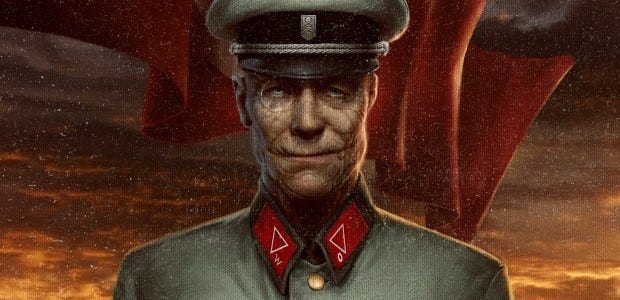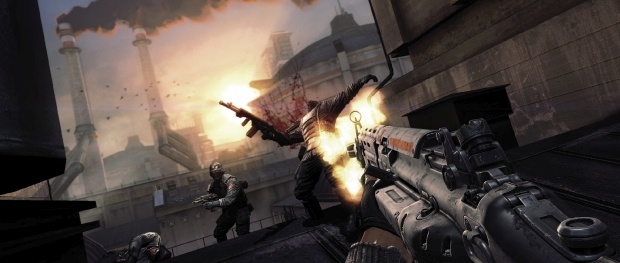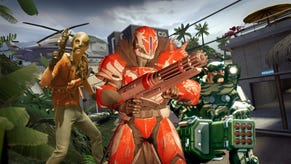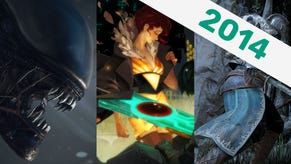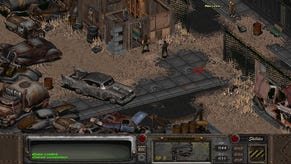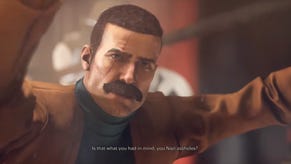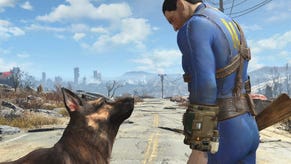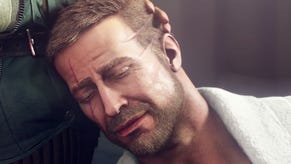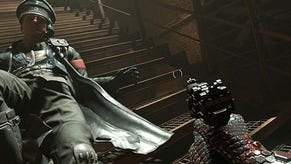Hands On - Wolfenstein: The New Order
Old Wolf, New Tricks
Update: This article has been updated to reflect the following factual corrections: your co-pilot is called Fergus, not Rufus; the cover system is still present in the game; a painting on the wall was of Deathshed, not the Fuhrer.
"In my dream, I smell the barbecue.
I hear children.
A dog.
I think I see someone.
Someone I love.
These things are not for me.
I move by roaring engines.
Among warriors.
We come from the night."
Gawp. Yawp. Goggle. B.J. Blazkowicz does beat poetry. This can’t be Wolfenstein? But it is.
Wolfenstein, father of the FPS genre, eternally damned by faint praise. Of all id’s properties, it has been most competently served by its sequels. Compared to the mediocrity of Quake 4 and Doom 3, the rebooted Wolfenstein games by Gray Matter and Raven are solid. Yet they’re also forgettable run and gun fests, with cartoon Nazis and basic FPS mechanics. Wolfenstein: The New Order is the third in the rebooted series, and attempts to be memorable, whilst maintaining its simple violent entertainment. But does it work?
The slice I played last week was an expanded version of what Jim experienced at GamesCom and what Quintin interpreted Brendan’s shorthand as meaning. We’re reprising the role again of American-Polish hero B.J. Blazkowicz. Deathshead (presumably not his birth name), the scientist-commander who survived 2009’s Wolfenstein has given the Nazis access to giant science-fiction robots which have almost won them the war. So B.J. is part of a huge flight of aircraft assaulting Deathshead’s base in the hope of taking him out and giving the Allies a chance.
After B.J’s poetic dream-monologue, the game begins with a little interior plane adventure, as you dump cargo, play with the radar, man the guns and generally get to explore a 1946 Allied cargo plane. Eventually your bird takes one head-on collision with a fighter plane too many, and you and your Scottish co-pilot Rufus Fergus jump across to a nearby troop transport that’s just lost its pilot. Then you all fall out of that plane, the Captain America pastiche ends, and the D-Day re-enactment begins. What’s that? You don’t remember giant-robot-hellhounds from D-Day? Funny…
Having eliminated the hounds, you and the survivors gradually fight your way up the beach and through the standards of the genre. You run along trenches, throw explosives into machine-gun nests, tear heavy machineguns from mountings, dual-wield machine guns and so on. It’s worth noting that the cover system Jim praised seems to have been stripped out. The cover system is still present - you don't stick to geometry like Gears of War's brutish soldiers, but you'll spend time hunkered behind scenery, using the directional lean to poke out and take potshots.
What’s different are the alternate paths. Pushing into one hangar, I’m confronted by all the Nazis in the world. After twenty years of playing first-person shooters (I suddenly feel so very, very old), even on the hardest difficulty, and with all their flanking and grenade-throwing, it’s not too hard to push through them. However, if I’d thrown a single grenade into the rocket store I found outside the hangar, it would have detonated and opened up an alternate route behind their defenses. Not original, no, but new to Wolfenstein.
These alternate paths can also be very Wolfenstein. Thirty minutes after a dozing B.J. mumbles that quote, I’m scaling the outer walls of a fortified tower with the corseted-grace of Adam West’s Batman, as planes explode above. Inside, I happen across a miniature shrine, reminiscent of the Fuhrer paintings present in Wolfenstein 3D. You know the kind of thing. Big painting of Deathshead. Suits of armour. Draped flags on the rough stone walls. All the faux medievalism of the pseudo-historical Teutonic Knights. Completely Wolfenstein.
One of the knight’s swords is bent, so I unconsciously, anally, bend to straighten it. It straightens. Deathshead’s stern visage recedes into the wall to reveal a secret passage. The passage leads to a vent in an office, where an officer is sitting at a fine old desk, presumably doing the Swastikaword. As the level designer has invited me to, I sneak up behind the officer and silently insta-kill him with my knife, preventing him from summoning reinforcements with his wired-in radio.
Note, bene. Not only have the developers taken a key element of the original Wolf 3D, the secret passages behind paintings. But they’d also recognised that this was a viable way to increase the diversity of paths through their game and encourage a different, stealthier, type of combat. Also, that’s exactly the stealth combat that comes from the original 1981 Castle Wolfenstein, which id had intended to put into Wolf 3D but cut because they created the FPS genre instead. And as he was the fifth officer I’d killed stealthily, I’d completed some objective hidden away in the game’s extensive menus and unlocked the ability to throw knives. Looking at the menu, I notice a whole other bunch of RPG menus too, with character descriptions and maps. It seems The New Order draws on not only Castle Wolfenstein and Wolf 3D but Wolfenstein RPG too.
All that new complexity doesn’t detract from The New Order’s FPSity. This is definitely a sequel to the founder of the FPS. The combat is fast and brutal, the AI is as smart-dumb as we’re used to, the weapons are as varied and lethal as you remember. Your head judder-judders with the flashes and sounds of unloading weaponry. Often I paused from firing just so the flashing would stop and I could tell if I’d actually managed to kill my enemy. Even the throwing knives have that near-silent snicker-snack as they embed in a officer’s neck or, more often, the tinkle of tumbling cutlery when you miss or accidentally throw a spoon.
But, in grand Wolfenstein tradition, it’s also a game about ludicrous bombast, built in a universe of NPCcidal physics. So when you’re not on a plane, it’s liable to explode at the slightest touch. When you’re on it, it’ll survive colliding head-on with another plane. When an NPC encounters a Ubersoldat, he’ll be turned to strawberry jam faster than you can bark ‘Mein Namen’. When that Ubersoldat punches you, B.J., you’ll grimace a little and keep shooting until he punches you another eight or so times. And this is on the second highest difficulty of “I am Death Incarnate” rather than “Don’t Hurt Me Daddy”.
Once you’ve climbed the tower and met up with the few other survivors of the assault, the game changes tone again, getting a bit silly and a bit gross. After meeting a few of Deathshead’s experiments, your team is trapped in a room. A smiley, leathery face appears at the window. An NPC shouts “it’s Deathshead”. And he babbles something about recognising B.J. before triggering the walls of your room to start crushing you. Because all rooms in villains’ fortresses have incinerators and mobile walls.
When you come around, it’s to a forced choice between the lives of your allies, which Jim has talked about before. It’s not pleasant, and the point of the scene is questionable (after all, we already know Nazis are evil), but it changes the game’s flow. Suddenly the narrative has changed from brave allies storming a castle, to brave allies getting tortured and running away. Barely escaping, B.J. jumps out of the castle window just as the room he was in explodes and he gets a big lump of shrapnel in his head. He plummets unconscious into the sea. Roll opening credits.
Then B.J. spends the next fourteen years as a shut-in patient in an asylum.
That’s no joke. The transition from the 1940s to the 1960s is an impressive cutscene, with brain-damaged B.J. watching each day pass as a single frame in a film. Similarly, conversations with a Polish family, with a pair of louche Gestapo officers on a train, and (another) torture scene are each performed with polished, in-engine animation. Machine Games can do well-written, well-animated cutscenes that, amazingly, I didn’t want to skip.
What comes next is the Wolfenstein that's going to fill your playtime. It’s the 1960s. The Nazis conquered the world. The USA got nuked. It's The Man in the High Castle, the action game. And B.J.is a lone out-of-era resistance fighter, in a wholly-Nazi world, looking mainly for revenge.
From what I saw, the game doesn’t change up much here. When B.J. comes around from fifteen years of cabbagedom, it’s that same shooter we had earlier, with divergent paths and optional mechanics. The family of the sole surviving asylum nurse (who you will have an inevitable romance with) agrees to help B.J. get to the prison where the surviving resistance fighters have been interned. And to get there, B.J. has to fight his way through checkpoints packed with Nazis, giant robots and some dreadfully annoying flying drones. It’s not exactly new, but it is enjoyable.
From the carefully-curated slice they showed us, it looks like Machine Games really *got* Wolfenstein. The mixture of camp and horror, the strong combat, the RPG integration, the secret passages, and the Nazis as comic book sadists. This is the best we can hope for from a modern Wolfenstein.
Yet I have a personal concern, coming from the core of Wolfenstein. Its choice of Hammer Horror subject matter - science-fiction, occultist Nazis - escaped Western criticism back in the early 90s when the industry was so niche. But it’s persistently caused problems in Germany, where each new game has to be extensively de-Nazified.
Perhaps Germany has it right. Perhaps we shouldn’t be leveraging for wacky entertainment one of the most horrible periods of human history. Wolfenstein is very much like Inglorious Basterds in that, however enjoyable we might find the spectacle of the moment-to-moment violence, there is no moral depth here. The forced choice that both Jim and I balked at is cruel and makes the player complicit in it - but beyond the chosen character not appearing later in the game, it’s gratuitous.
I'm unsure whether subject matter this morally-conflicted demands that we deal with it seriously. Half of modern-day Britain was raised on a diet of televised comedy Nazis in Allo Allo and Dad’s Army, continuing the propaganda caricatures from WWII. It’s completely normal that we think about Nazis as wacky - and it's easy to joke about Commander ‘Death Shed’, up until you stumble across the picture of an actual death shed from Ohrdruf.
Wolfenstein flits between gung-ho war, camp Nazis, mass-murder FPS and torture-horror. Yet it’s not the portrayal but the tone that’s off. By making these fictional Nazis out to be comically and inhumanly evil, the game is obfuscating that it was real, normal people who calmly and systematically eliminated millions of other humans.
